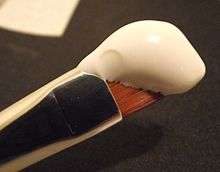Gesso

Gesso (Italian pronunciation: [ˈdʒɛsso]; "chalk", from the Latin: gypsum, from Greek: γύψος) is a white paint mixture consisting of a binder mixed with chalk, gypsum, pigment, or any combination of these.[1] It is used in artwork as a preparation for any number of substrates such as wood panels, canvas and sculpture as a base for paint and other materials that are applied over it.
Traditional gesso
"Gesso", also known "glue gesso" or "Italian gesso"[2] is a traditional mix of an animal glue binder (usually rabbit-skin glue), chalk, and white pigment, used to coat rigid surfaces such as wooden painting panels as an absorbent primer coat substrate for painting. The colour of gesso was usually white or off-white. Its absorbency makes it work with all painting media, including water-based media, different types of tempera, and oil paint. It is also used as a base on three-dimensional surfaces for the application of paint or gold leaf.[3] Mixing and applying it is an art form in itself since it is usually applied in 10 or more extremely thin layers. It is a permanent and brilliant white substrate used on wood, masonite and other surfaces. The standard hide glue mixture is rather brittle and susceptible to cracking, thus making it suitable for rigid surfaces only. For priming flexible canvas, an emulsion of gesso and linseed oil, also called "half-chalk ground", is used.[4] In geology, the Italian "gesso" corresponds to the English "gypsum", as it is a calcium sulfate mineral (CaSO4·2H2O).
Use in Sculpture
Gesso is also used by sculptors to prepare the shape of the final sculpture (fused bronze) or directly as a material for sculpting. Gesso can also be used as a layer between sculptured wood and gold leaf. In this case, a layer of red shellac called "assiette" is used to cover the gesso before applying the gold.
Acrylic "gesso"
Modern "acrylic gesso" is a widely used ground[5] that is a combination of calcium carbonate with an acrylic polymer medium latex, a pigment and other chemicals that ensure flexibility, and increase archival life. It is technically not gesso at all[6][7] and its non-absorbent acrylic polymer base makes it incompatible with media that require traditional gesso such as egg tempera.[8] It is sold premixed for both sizing and priming panels and flexible canvas for painting. While it does contain calcium carbonate (CaCO3) to increase the absorbency of the primer coat, titanium dioxide or "titanium white" is often added as the whitening agent. This allows gesso to remain flexible enough to use on canvas.
Acrylic gesso can be colored, either commercially by replacing the titanium white with another pigment, such as carbon black, or by the artist directly, with the addition of an acrylic paint. Acrylic gesso can be odorous, due to the presence of ammonia and/or formaldehyde, which are added in small amounts as preservatives. Art supply manufacturers market canvases pre-primed with gesso.
The Painter's Handbook notes a problem with using oil paints over an acrylic gesso ground instead of a traditional oil ground, citing a mismatch in flexibility over time that could cause the oil paint to delaminate.[9]
Soy-based "gesso"
Soy-based gesso is a low-emitting, bio-based "gesso" made from recycled soy content. Soy gesso is made with bio-based dispersion technology that uses a soy ester with a modified vegetable(soy) oil acrylic. The surface is similar to acrylic gesso, but is not a solid acrylic. Soy gesso is made using a thin film of a modified acrylic and the soy ester. An advantage of soy gesso is that the penetration and adhesion of the soy ester to the substrate and the thin film of modified acrylic may create a surface that allows a physical bond between the gesso and oil paint. In addition, the thinner modified acrylic film is more resistant to cracking than a solid acrylic gesso.
See also
References and sources
- References
- ↑ The materials and techniques of medieval painting By Daniel Varney Thompson. page 32. Books.google.com. Retrieved 2014-04-09.
- ↑ The painter's handbook: a complete reference By Mark David Gottsegen. page 321 Archived June 3, 2015 at the Wayback Machine
- ↑ Lettering & Calligraphy Workbook By Diagram Group, page 148. Books.google.com. Retrieved 2014-04-09.
- ↑ The painter's handbook: a complete reference By Mark David Gottsegen, page 64 Archived January 22, 2014 at the Wayback Machine
- ↑ Elizabeth Tolley, Oil Painter's Solution Book - Landscapes: Over 100 Answers to Your Oil Painting, page 28. Books.google.com. Retrieved 2014-04-09.
- ↑ The painter's handbook: a complete reference, by Mark David Gottsegen. Page 321 Archived June 3, 2015 at the Wayback Machine
- ↑ Michael Friel, Still Life Painting Atelier: An Introduction to Oil Painting, Random House Digital, Inc 2010, page 58. Books.google.com. Retrieved 2014-04-09.
- ↑ Altoon Sultan, Luminous Brush: Painting with Egg Tempera, page 33. Books.google.com. Retrieved 2014-04-09.
- ↑
 Scholarly quote of a single paragraph from the book "The Painter's Handbook: A Complete Reference, page 60" by Gottsegen, Mark David.
Scholarly quote of a single paragraph from the book "The Painter's Handbook: A Complete Reference, page 60" by Gottsegen, Mark David.
- Sources
| Wikimedia Commons has media related to Art made from gypsum. |